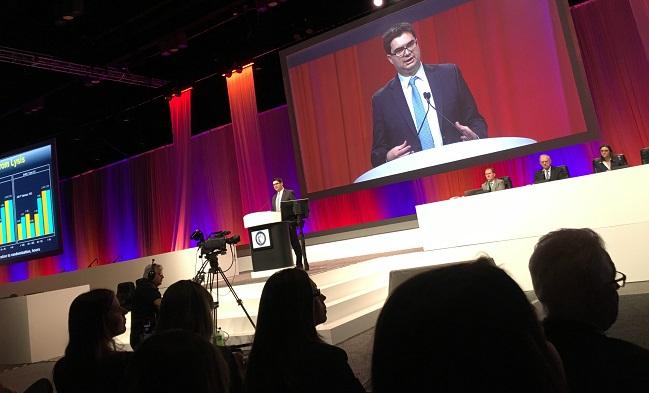TREAT: No Major Bleeds With Ticagrelor in ACS Patients After Fibrinolysis
At 30 days, ticagrelor was noninferior to clopidogrel in terms of major bleeding. Any efficacy differences await further follow-up, investigators say.

ORLANDO, FL—Ticagrelor appears to be as safe as clopidogrel among patients with ST-segment elevation myocardial infarction treated with fibrinolysis, at least in terms of TIMI major bleeding at 30 days, the TREAT trial shows.
Longer-term follow-up will help determine whether any efficacy differences—or late safety issues— emerge over time, Otavio Berwanger, MD (São Paulo Cardiac Hospital, Brazil), said during his late-breaking clinical trial presentation here at the American College of Cardiology 2018 Scientific Session.
While immediate transfer for PCI is well established as the treatment strategy for acute MI, it’s simply not a reality in many parts of the world, he said. Two large, randomized clinical trials have established the safety of aspirin plus clopidogrel for reducing MACE in STEMI patients treated with fibrinolysis—CLARITY and COMMIT—but the large, randomized PLATO trial, which established ticagrelor’s supremacy over clopidogrel in ACS, excluded patients treated with fibrinolysis. No large trial, Berwanger stressed, has looked at the safety and efficacy of ticagrelor in this setting.
TREAT was conducted in 10 countries worldwide including a mix of developed and developing nations. Investigators enrolled 3,799 patients under the age of 75 and treated with fibrinolysis. They were then randomized to 180 mg ticagrelor (Brilinta; AstraZeneca) as early as possible after the index event (within 24 hours) then followed by 90 mg twice daily for 12 months or to 300 mg of clopidogrel as early as possible, followed by 75 mg/day for 12 months. Fibrinolysis was typically initiated within a mean of 2.6 hours in both groups, while study drug randomization typically occurred within 11.5 hours postfibrinolysis.
For the primary outcome of TIMI major bleeding, there was no difference between study arms, with major bleeds seen in approximately 0.7% of both groups. No difference was seen when other definitions of major bleeding were used. TIMI minimal bleeding occurred more often in ticagrelor-treated patients, at least according to PLATO definitions.
“In patients under age 75 with STEMI, delayed administration of ticagrelor after fibrinolytic therapy was noninferior to clopidogrel for TIMI major bleeding at 30 days,” Berwanger concluded. “Minor bleeding was increased with ticagrelor, and there was no benefit on efficacy outcomes.”
Investigators plan to report 12-month follow-up at a future date, as well as dig into outcomes among the subset of patients who ultimately went on to have PCI—approximately 56% of TREAT participants, Berwanger said.
More Questions
Following his presentation, Berwanger was asked why the study was designed to show noninferiority, not superiority.
“We discussed the possibility of doing an efficacy trial, which of course remains an important question,” he replied. “That would require another PLATO, another trial of 18,000 patients, which was not possible with the funding that we had as an investigator-initiated trial.”
Beyond efficacy, he said, the next “relevant question” is safety. And in this sense, he said, “this trial [offers] another piece in the puzzle . . . I think a lot of physicians are a bit concerned about using ticagrelor in this patient population, whether it is safe.”
Another point of contention was the delay between fibrinolysis and antiplatelet drug randomization. That delay was a bit longer than ideal, Berwanger acknowledged during his presentation. “The main issue here was logistics,” he explained, noting that some of the regional hospitals had no research infrastructure and simply getting patients randomized to study drug within 24 hours was an achievement in and of itself. “It’s very challenging to conduct studies in this setting,” Berwanger said.
This leaves a key question unanswered, physicians say—namely, what would happen in patients who received fibrinolysis and ticagrelor at the same time.
As Clyde Yancy, MD (Northwestern University Feinberg School of Medicine, Chicago, IL), and Robert Harrington, MD (Stanford University, CA), write in an editorial accompanying the study’s simultaneous publication in JAMA Cardiology, “The crucial question that needs to be addressed—concomitant use of ticagrelor with lytic therapy for acute revascularization—remains unanswered in this trial. Given the worldwide burden of acute coronary syndromes and the recognized exigencies which preclude the ubiquitous availability of PCI, we believe this question needs urgent attention.”
Speaking with TCTMD, Craig J. Beavers, PharmD (University of Kentucky Healthcare, Lexington), pointed out that while TREAT was conducted outside of the United States, patients treated by lytics and transferred for PCI are not uncommonly seen, even in major US hospitals. The issue is whether patients can be safely switched from clopidogrel to ticagrelor after lysis. “It can happen at least one or two times a week on our service, and this data makes me feel better that if we make that change, we know from a safety standpoint they will be okay,” Beavers said. “And then, if you extrapolate from PLATO, you would also think that there will be fewer events down the line.”
Where Beavers says he still has concerns is in elderly patients, who were excluded from TREAT, and who would be particularly susceptible to bleeding particularly if they were started on ticagrelor at the same time of lysis.
Shelley Wood is the Editor-in-Chief of TCTMD and the Editorial Director at CRF. She did her undergraduate degree at McGill…
Read Full BioSources
The writing committee for the TREAT study. Ticagrelor vs clopidogrel after fibrinolytic therapy in patients with ST-elevation myocardial infarction: a randomized clinical trial. JAMA Cardiol. 2018;Epub ahead of print.
Yancy CW, Harrington RA. The TREAT trial—moving ST-elevation myocardial infarction care forward, with more to do. JAMA Cardiol. 2018;Epub ahead of print.


Comments